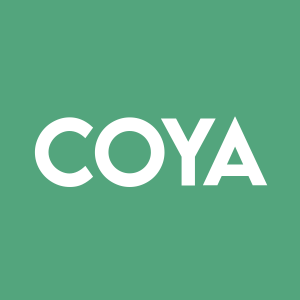Coya Therapeutics Announces Positive Results of a Double-Blind Study of Subcutaneous Low-Dose Interleukin-2 (LD IL-2) in Alzheimer’s Disease (AD) Presented at the Clinical Trials on Alzheimer’s Disease Conference (CTAD24) in Madrid (Spain)
- Study met Primary and Secondary Endpoints for Safety and Regulatory T cell (Treg) Cell Population Enhancement, respectively, with no off-target effects on T effector lymphocytes, providing further evidence of target engagement
- Exploratory Endpoints demonstrated cognitive stabilization on treatment vs. cognitive declines on placebo for LD IL-2 dosing every 4 weeks (LD IL-2 q4wks), which was associated with significant improvement in cerebrospinal fluid (CSF) soluble Aβ42 levels and stabilized CSF Neurofilament Light Chain (NfL)
- Study supports and increases confidence in Treg modulation strategies in neurodegenerative conditions and in advancing LD IL-2 q4wks and LD IL-2 q4wks combination strategies (i.e. COYA 302) in AD and other related diseases
“We want to express our gratitude to the investigators for this study. We believe this trial strongly supports and adds further validation of Coya’s approach in modulating Treg function as a platform to address neurodegenerative diseases,” said Arun Swaminathan, Ph.D., incoming CEO of Coya. “These monotherapy treatment results increase our confidence that combinations of COYA 301, our proprietary LD IL-2, with other drug targets have strong potential in treating Alzheimer's Disease. In addition, this data on LD IL-2 alone provides additional confidence in COYA 302, our proprietary combination of LD IL-2 and cytotoxic T lymphocyte-associated antigen 4 immunoglobulin fusion protein (CTLA4-Ig) in amyotrophic lateral sclerosis (ALS) and frontotemporal dementia (FTD) based on increased and more durable Treg suppressive function observed with the combination in patients with ALS.”
Study Design:
The investigator-initiated, randomized, double-blind, placebo-controlled Phase 2 trial evaluated two dosing regimens of subcutaneous low-dose interleukin-2 in 38 participants with Alzheimer’s disease that were between the ages of 50 to 86 and had Mini-Mental State Examination (MMSE) scores ranging from 12 to 26.
Of the 38 total participants, 22 were randomized in a 1:1 ratio to receive either 5 days of LD IL-2 (106 IU/day) (LD IL-2 q4wks) or placebo every 4 weeks for 21 weeks. An additional 16 participants were randomized in a 2:1 ratio to receive 5-day cycles of LD IL-2 every 2 weeks (LD IL-2 q2wks) or placebo for the same 21-week duration. All participants were monitored for 9 weeks post-treatment, resulting in a total study period of 30 weeks. Demographics and baseline disease characteristics were comparable among the treatment groups.
The primary endpoint was the incidence and severity of adverse events (AEs), with the secondary endpoint evaluating changes in Tregs. Exploratory endpoints assessed changes in cerebrospinal fluid (CSF), AD-related biomarkers, and cognitive status.
Study Results:
The study successfully met its primary and secondary endpoints, demonstrating that treatment with low-dose interleukin-2 is safe and well-tolerated in patients with Alzheimer’s disease. Notably, LD IL-2 showed targeted biological activity, evidenced by a significant expansion of regulatory T cell populations in the LD IL-2 q4wks group without any off-target effects on other peripheral lymphocytes. Additionally, the q4wks regimen led to significant improvements (defined by increased levels) in cerebrospinal fluid (CSF)-soluble Aβ42 levels, an indicator of amyloid pathology, and showed a promising trend in stabilizing cognitive function, with a clinically meaningful 4.93-point improvement1 in the ADAS-Cog14 score compared to placebo.
In contrast, the q2wks group, representing the higher total dose cohort, did not exhibit benefits in exploratory endpoints, underscoring the importance of appropriate IL-2 dosing for maintaining Treg functionality and its associated effects on CSF biomarkers and cognitive outcomes. LD IL-2 q2wks dosing also resulted in a reduction of Foxp3 expression, a critical marker of Treg functionality (a lower level or loss of Foxp3 expression is associated with unstable/dysfunctional Tregs). While these unstable Tregs continue to show suppressive immune response in vitro, they may lose their immunomodulatory functions in vivo, potentially explaining the dose impact on Treg populations and associated exploratory endpoints. As a result of these data, the Company will likely advance LD IL-2 q4wks.
Primary Endpoint (Safety and Tolerability): All patients completed the 21-week treatment phase. The proportion of patients experiencing adverse events (AEs) was similar between the LD IL-2 treatment groups and the placebo group, with no serious AEs or deaths reported. The most common AEs in the LD IL-2 groups included mild erythema at the injection site and a slight increase in eosinophil counts.
Secondary Endpoint (Treg Cell Populations): There was a significant increase (p < 0.05) in the percentage of CD4+ FOXP3+CD25 high Tregs, mean fluorescence intensity (MFI) of Foxp3, Treg CD25 MFI, and Treg suppression of T responders following both dosing regimens of LD IL-2 treatment compared to placebo. Notably, the LD IL-2 q4wks treatment group showed greater enhancement in both Treg numbers and Foxp3 MFI compared to the q2wks group. The loss of Foxp3 expression in the q2wks group (back to baseline levels equivalent to placebo) indicated that higher IL-2 dosing may compromise Treg functionality. Repeated stimulation of Tregs without sufficient rest periods has been reported to result in exhausted and unstable Treg populations2. Published studies also suggest an inverse relationship between IL-2 dose and Treg functionality3,4.
- For patients with mild AD, a change of +3 on the ADAS-Cog has been described as clinically meaningful to assess worsening (Muir et al., Alzheimer’s Dement 2024; 20:3352–3363).
- Hoffmann, et al. Loss of FOXP3 expression in natural human CD4+CD25+ regulatory T cells upon repetitive in vitro stimulation. Eur J Immunol 2009; 39 (4): 1088-1097.
- Gao et al., Dynamically modeling the effective range of IL-2 dosage in the treatment of systemic lupus erythematosus. iScience 2022; 25: 104911
- Moon B-I., et al., Functional Modulation of Regulatory T Cells by IL-2. PLoS ONE 2015; 10(11)
Exploratory Endpoint (Cognitive Function & Cerebrospinal Fluid (CSF) Biomarkers):
Although not powered for significance, the analyses of exploratory endpoints also showed encouraging results.
Cognitive Function: The Alzheimer’s Disease Assessment Scale–Cognitive Subscale (ADAS-Cog14) scores on day 148 showed a slight improvement following LD IL-2 q4wks administration (change from baseline: -0.450), vs. placebo, which worsened 4.480 from baseline, demonstrating a clinically meaningful difference of 4.93 points (P=0.061). This cognitive effect was not observed in the LD IL-2 q2wks administration, which demonstrated a similar decline as placebo.
Stabilization of ADCS-CGIC (Alzheimer's Disease Assessment Scale – Cognitive Subscale) scores was observed in both the IL-2 q4wks and IL-2 q2wks groups on day 148 compared to the placebo arm, which declined from baseline.
The change from baseline in the Clinical Dementia Rating Scale Sum of Boxes (CDR-SOB) on Day 148 was 1.401 in the LD IL-2 q4wks group, 1.976 in the LD IL-2 q2wks group, and 1.893 in the placebo group, suggesting a
CSF Aβ42: Low CSF Aβ42 is universally associated with AD, and higher CSF Aβ42 levels are independently associated with slowing cognitive impairment and clinical decline. Increases in Aβ42 may represent a mechanism of potential benefit of intervention. LD IL-2 q4wks treatment significantly improved CSF Aβ42 levels after the 21-week treatment, compared to the placebo group (p = 0.045). LD IL-2 q2wks treatment did not significantly modify CSF Aβ42 levels. These data further suggest the dose-dependent effect of LD IL-2 on Treg cell populations (i.e. FOXP3) is associated with effects on CSF Aβ42.
CSF Neurofilament Light Chain (NfL): NfL is increasingly recognized as a promising biomarker for neurodegeneration (neuronal/axonal degeneration) in AD. Residing predominantly within myelinated axons, NfL is a cytoskeletal protein that plays a role in maintaining neuronal structural integrity and axonal caliber. Neuronal damage in neurodegenerative diseases releases NfL into the extracellular space and eventually into the CSF, resulting in higher CSF NfL levels in AD.
CSF NfL levels remained stable following LD IL-2 q4wks administration and almost reached statistical significance vs. placebo (which increased by 217.3pg/mL) (p=0.060). CSF NfL increased by 148.0 pg/mL in the LD IL-2 q2wks arm. These data suggest the dose-dependent effect of LD IL-2 on Treg cell populations (i.e. FOXP3) is associated with effects on CSF NfL.
CSF Glial Fibrillary Acidic Protein (GFAP): GFAP is an astrocytic cytoskeleton intermediate filament protein. GFAP is a marker of astrogliosis, which is the abnormal activation and proliferation of astrocytes. Astrogliosis is associated with Aβ plaques in the prodromal stages of AD.
CSF GFAP levels showed a slight improvement following LD IL-2 q4wks administration (change from baseline: -214.1 pg/mL) and remained almost stable in the LD IL-2 q2wks group (change from baseline: 17.4 pg/mL), but increased by 1548.99 pg/mL in the placebo group.
About Alzheimer’s Disease
Alzheimer's disease is the most common cause of dementia, a general term for memory loss and other cognitive abilities serious enough to interfere with daily life. Alzheimer's disease accounts for up to
- Alzheimer’s Association (www.alz.org)
- Centers for Disease Control and Prevention (www.cdc.gov)
About COYA 301
COYA 301 is the company’s proprietary investigational low-dose interleukin-2 (IL-2) intended to enhance the anti-inflammatory function of regulatory T cells (Tregs) and is designed for subcutaneous administration. COYA 301 is an investigational product not yet approved by the FDA or any other regulatory agency.
About COYA 302
COYA 302 is an investigational and proprietary biologic combination therapy with a dual immunomodulatory mechanism of action intended to enhance the anti-inflammatory function of regulatory T cells (Tregs) and suppress the inflammation produced by activated monocytes and macrophages. COYA 302 is comprised of proprietary low dose interleukin-2 (LD IL-2) and cytotoxic T lymphocyte-associated antigen 4 immunoglobulin fusion protein (CTLA-4 Ig) and is being developed for subcutaneous administration for the treatment of patients with ALS, FTD, and Parkinson’s Diseases (PD). These mechanisms may have additive or synergistic effects.
In February of 2023, Coya announced results from a proof-of-concept, open-label clinical study evaluating commercially available LD IL-2 and CTLA-4 Ig in a small cohort of patients with ALS conducted at the Houston Methodist Research Institute (
During the 48-week treatment period, the therapy was well tolerated. The most common adverse event was mild injection-site reactions. No patient discontinued the study, and no deaths or other serious adverse events were reported.
Patients' disease progression was measured using the ALSFRS-R scale, a validated rating tool for monitoring the progression of disability in patients with ALS. The mean (±SD) ALSFRS-R scores at week 24 (33.75 ±3.3) and week 48 (32 ±7.8) after initiation of treatment were not statistically different compared to the ALSFRS-R score at baseline (33.5 ±5.9), suggesting significant amelioration in the progression of the disease over the 48-week treatment period.
Treg suppressive function, expressed as a percentage of inhibition of proinflammatory T cell proliferation, showed a statistically significant increase over the course of the treatment period and was significantly reduced at the end of the 8-week washout post-treatment period. Treg suppressive function at 24 weeks (79.9 ±9.6) and 48 weeks (89.5 ±4.1) were significantly higher compared to baseline (62.1 ±8.1) (p<0.01), suggesting enhanced and durable Treg suppressive function over the course of treatment. In contrast, Treg suppressive function (mean ±SD) was significantly decreased at the end of the 8-week washout period compared to end-of-treatment at week 48 (70.3 ±8.1 vs. 89.5 ±4.1, p <0.05).
The study also evaluated serum biomarkers of inflammation, oxidative stress, and lipid peroxides. The available data up to 16 weeks after initiation of treatment suggest a decrease in these biomarker levels, which is consistent with the observed enhancement of Treg function. The evaluation of the full biomarker data is ongoing.
COYA 302 is an investigational product not yet approved by the FDA or any other regulatory agency.
About Coya Therapeutics, Inc.
Headquartered in
Coya’s investigational product candidate pipeline leverages multiple therapeutic modalities aimed at restoring the anti-inflammatory and immunomodulatory functions of Tregs. Coya’s therapeutic platforms include Treg-enhancing biologics, Treg-derived exosomes, and autologous Treg cell therapy.
COYA 302 – the Company’s lead biologic investigational product or “Pipeline in a Product”– is a proprietary combination of COYA 301 (Coya’s proprietary LD IL-2) and CTLA4-Ig for subcutaneous administration with a unique dual mechanism of action that is now being developed for the treatment of Amyotrophic Lateral Sclerosis, Frontotemporal Dementia, Parkinson’s Disease, and Alzheimer’s Disease. Its multi-targeted approach enhances the number and anti-inflammatory function of Tregs and simultaneously lowers the expression of activated microglia and the secretion of pro-inflammatory mediators. This synergistic mechanism may lead to the re-establishment of immune balance and amelioration of inflammation in a sustained and durable manner that may not be achieved by either low-dose IL-2 or CTLA4-Ig alone.
For more information about Coya, please visit www.coyatherapeutics.com
Forward-Looking Statements
This press release contains “forward-looking” statements that are based on our management’s beliefs and assumptions and on information currently available to management. Forward-looking statements include all statements other than statements of historical fact contained in this presentation, including information concerning our current and future financial performance, business plans and objectives, current and future clinical and preclinical development activities, timing and success of our ongoing and planned clinical trials and related data, the timing of announcements, updates and results of our clinical trials and related data, our ability to obtain and maintain regulatory approval, the potential therapeutic benefits and economic value of our product candidates, competitive position, industry environment and potential market opportunities. The words “believe,” “may,” “will,” “estimate,” “continue,” “anticipate,” “intend,” “expect,” and similar expressions are intended to identify forward-looking statements.
Forward-looking statements are subject to known and unknown risks, uncertainties, assumptions and other factors including, but not limited to, those related to risks associated with the impact of COVID-19; the success, cost and timing of our product candidate development activities and ongoing and planned clinical trials; our plans to develop and commercialize targeted therapeutics; the progress of patient enrollment and dosing in our preclinical or clinical trials; the ability of our product candidates to achieve applicable endpoints in the clinical trials; the safety profile of our product candidates; the potential for data from our clinical trials to support a marketing application, as well as the timing of these events; our ability to obtain funding for our operations; development and commercialization of our product candidates; the timing of and our ability to obtain and maintain regulatory approvals; the rate and degree of market acceptance and clinical utility of our product candidates; the size and growth potential of the markets for our product candidates, and our ability to serve those markets; our commercialization, marketing and manufacturing capabilities and strategy; future agreements with third parties in connection with the commercialization of our product candidates; our expectations regarding our ability to obtain and maintain intellectual property protection; our dependence on third party manufacturers; the success of competing therapies or products that are or may become available; our ability to attract and retain key scientific or management personnel; our ability to identify additional product candidates with significant commercial potential consistent with our commercial objectives; ; and our estimates regarding expenses, future revenue, capital requirements and needs for additional financing.
We have based these forward-looking statements largely on our current expectations and projections about future events and trends that we believe may affect our financial condition, results of operations, business strategy, short-term and long-term business operations and objectives, and financial needs. Moreover, we operate in a very competitive and rapidly changing environment, and new risks may emerge from time to time. It is not possible for our management to predict all risks, nor can we assess the impact of all factors on our business or the extent to which any factor, or combination of factors, may cause actual results to differ materially from those contained in any forward-looking statements we may make. In light of these risks, uncertainties and assumptions, the forward-looking events and circumstances discussed herein may not occur and actual results could differ materially and adversely from those anticipated or implied in the forward-looking statements. Although our management believes that the expectations reflected in our forward-looking statements are reasonable, we cannot guarantee that the future results, levels of activity, performance or events and circumstances described in the forward-looking statements will be achieved or occur. We undertake no obligation to publicly update any forward-looking statements, whether written or oral, that may be made from time to time, whether as a result of new information, future developments or otherwise.
View source version on businesswire.com: https://www.businesswire.com/news/home/20241029490704/en/
Investors
David
david@coyatherapeutics.com
CORE IR
Bret Shapiro
brets@coreir.com
561-479-8566
Media
For Coya Therapeutics:
Kati Waldenburg
media@coyatherapeutics.com
212-655-0924
Source: Coya Therapeutics, Inc.






